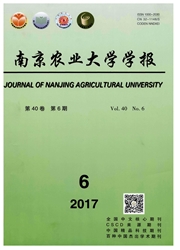

 中文摘要:
中文摘要:
[目的]本文旨在探讨人工可控环境中满足灌浆期冬小麦生长发育的适宜光密度。[方法]以小麦品种‘扬麦16’为试验材料,自然光照+自然春化为对照(CK),设置人工光照(650μmol·m-2·s-1)+自然春化(T1)、人工光照(500μmol·m-2·s-1)+自然春化(T2)、人工光照(650μmol·m-2·s-1)+种芽春化(T3)、人工光照(500μmol·m-2·s-1)+种芽春化(T4)4个组合处理,研究了冬小麦灌浆期旗叶对光密度与春化方式的光合响应。[结果]T1、T2、T3和T4处理的千粒质量、旗叶Pn相对增率(VPn)和蒸腾速率均大于CK;T3、T4的光合潜能(Pmax)高于T1、T2和CK;T1的光饱和点高于T2,T3高于T4;T2的光补偿点和暗呼吸速率均低于T1,T4低于T3;T1的气孔导度高于T2,T3高于T4;T3、T4的旗叶气孔导度高于T1和T2。CK及T1、T2、T3、T4处理的千粒质量分别为33.58、47.67、44.42、49.66、46.31 g。[结论]500~650μmol·m-2·s-1是人工可控环境中灌浆期‘扬麦16’生长发育的适宜光密度参数。
 英文摘要:
英文摘要:
[ Objectives] The aim of this study is to study the reasonable light intensity for winter wheat in the filling stage in artificial controllable environment. [ Methods ] The wheat variety' Yangmai 16' was used as the experimental material. We set up four treatments: artificial light( 650 μmol m-2 s-l ) + natural vernalization ( T1 ), artificial light ( 500 μmol. m-2 s-1 ) + natural vernalization ( T2 ), artificial light ( 650 μmol, m-2 s-1 ) +seed vernalization ( T3 ), artificial light ( 500 μmol m-2. s-1 ) + seed vernalization ( T4), and natural light+natural vernalization was used as control(CK). The photosynthetic responses of flag leaf in the filling stage of winter wheat to light intensity and vernalization way were investigated. [ Resets] The results showed that the 1 000-grain weight, relative increase of flag leaf P.( Vp. ) and transpiration rate of four treatments were greater than those of CK treatment. The maximum net photosynthetic rate (Pmax) of T3 and T4 were greater than that of T1 ,T2 and CK. The light saturation point( LSP )of T1 treatment was greater than T2 ,and T3 was greater than T4. The light compensation point(LCP) and dark respiration rate (Rd )of T2 were lower than T1, and T4 were lower than T3. The stomatal conductance ( Gs ) of T1 treatment was greater than T2, and T3 was greater than T4. The Gs of flag leaf of T3 and T4 were greater than T1 and T2. [ Conclusions ] The light intensity of 500- 650 μmol m-2 s-1 was the reasonable light intensity parameter for the growth and development of Yangmai 16' in the filling stage in artificial controllable environment.
 同期刊论文项目
同期刊论文项目
 同项目期刊论文
同项目期刊论文
 期刊信息
期刊信息
